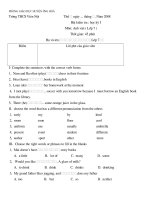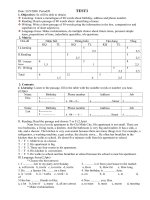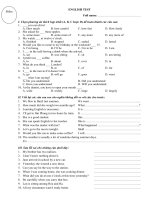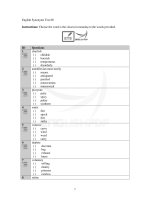Softwaretesting 08 eng
Bạn đang xem bản rút gọn của tài liệu. Xem và tải ngay bản đầy đủ của tài liệu tại đây (1.74 MB, 62 trang )
ソフトウェアテスト
[8] テストの評価と信頼性評価と信頼性と信頼性信頼性
Software Testing
[8] Evaluation of testing and reliability
あまん ひろひさ ひろひさ
阿萬 裕久 裕久( AMAN
Hirohisa )
(C) 2007-2022 Hirohisa AMAN
1
Evaluation of the test
Testing is the activity of quality assur
ance of software
Perfect Testing
⇒ There is no defect (fault) and no failure occurs.
There are no so-called "bugs".
Evaluation of “Testing Activities” is ne
cessary
Evaluation based on Coverage rate
Evaluation based on Bug resolution rate
Evaluation based on Operability
(C) 2007-2022 Hirohisa AMAN
2
Test evaluation (1)
Evaluation based on coverage rate
Evaluation from the perspective of "h
ow much you covered”
Focuse on state change
Focuse on Operation and input/output
according to specifications
*black box testing
Focus on Flow of program execution of program execution
*w of program executionhite box testing
(C) 2007-2022 Hirohisa AMAN
3
Test evaluation (2)
Evaluation based on bug resolution rate
Testing finds bugs and fixes them
If the total number of bugs is known, it i
s possible to evaluate the testing activit
y from the number of resolutions in it.
Bug's number of bugs resolved
=
resolution rate
total number of bugs
*Note: The term bug is not accurate;
A phenomenon that does not work properly ("failure, defect") is found
in the test, and "resolution" is to solve the "fault" that is the source of
problem or the "error" that created it.
(C) 2007-2022 Hirohisa AMAN
4
How to know "bug total"
In conclusion, the true number is not
known
Comparing humans to a system is like trying
to figure out how many times in a lifetime th
ey get sick.
If we consider that “the occurrence of a prob
lem = the symptoms of a disease," A fault is
a bacterial or virus that caused it, & an error
is an act that leads to the infection.
Estimate total number of bugs Statistically
(C) 2007-2022 Hirohisa AMAN
5
Bug number estimation method ① c c
apture/recapture method (1/4)
[Example]
I want to find out how many black bass
are in Lake Biwa.
*It would be nice if we could catch all t
he fish in Lake Biwa, but that is practi
cally impossible.
(C) 2007-2022 Hirohisa AMAN
6
Bug number estimation method ① c c
apture/recapture method (2/4)
1. Once you catch a suitable number of
black bass.
2. Then, Mark the black bass and let it e
scape.
3. After some time, the black bass are c
aptured again, and the total number
is estimated by how many marked on
es are included in it.
(C) 2007-2022 Hirohisa AMAN
7
Bug number estimation method ① c c
apture/recapture method (3/4)
The image will like this
Marking
10 fishes
for the
first time
2nd time, 2
out of 10
fishes
confirmed
markings
Recaptured
After that
mation of percentage of total
=2:8
:
This image diagram
10 : ? = 2 : 8
So there are 40 left
(C) 2007-2022 Hirohisa AMAN
8
Bug number estimation method ① c c
apture/recapture method (4/4)
Applying this to software
1. Prepare artificial bugs (marking)
2. Suppose that the test finds artificial bugs
and non-real bugs.
3. The total number of real bugs is estimate
d by the following equation. the follow of program executioning equation.
Than
(C) 2007-2022 Hirohisa AMAN
𝑛𝑦
𝑥
9
Disadvantages of the capture /
recapture method
It's hard to make realistic artificial bugs
Inevitably, it becomes a bug that seems to b
e intentional, and it is found immediately
As an engineer, there is resistance to "creati
ng bugs" (voice in the field)
They release "catchable" fish, and the es
timated number is smaller than it actuall
y is.
𝑛𝑦
* is smaller and is
𝑥
larger than it should be.
(C) 2007-2022 Hirohisa AMAN
10
Bug number estimation method (2)
Two-step editing method (1/3)
Improved capture/recapture method wi
thout artificial bugs
1. Prepare tw of program executiono test groups A, B
2. Group A tests and records any bugs fou
nd (keeping them secret to B)
3. Group B tests and estimates the numbe
r of remaining bugs based on how of program execution man
y the following equation. of the bugs found w of program executionere the same as A.
(C) 2007-2022 Hirohisa AMAN
11
Bug number estimation method (2)
Two-step editing method (2/3)
Think like a capture-recapture method
Group
A
found
10
bugs
Group B
Found in
2 out of 10
contained
w of program executionhat w of program executione
found in A
mation of percentage of total
:
10 : ? = 2 : 8
So there are 40 bugs
=2:8
that have not been
found in A.
(C) 2007-2022 Hirohisa AMAN
12
Bug number estimation method (2)
Two-step editing method (3/3)
Number of bugs found by group A =
Number of bugs found by group B =
Number of bugs found in both =
Than
𝒂(𝒃 − 𝒄)
Number of bugs A hasn’t found = 𝒄
The total number of bugs (including those found) is:
𝒂 (𝒃 − 𝒄)
𝒂𝒃 𝒂𝒄
𝒂𝒃
+ 𝒂=
−
+𝒂=
𝒄
𝒄
𝒄
𝒄
(C) 2007-2022 Hirohisa AMAN
13
Features of Two-step editing metho
d
No need to prepare artificial bugs
(Estimation can be made only with real bu
gs)
Since the two teams need to test separa
tely, which is more time consuming and
costly
Estimates smaller than they actually are
(C) 2007-2022 Hirohisa AMAN
14
[Exercise 1]
① c Find an estimate of the total number of bugs
Group A finds 10 bugs,
Group B finds 50 bugs.
However, 5 were found in both groups.
② Find an estimate of the number of remaining
bugs (not found yet).
Group A finds 100 bugs,
Group B finds 80 bugs.
However, 20 were found in both groups.
(C) 2007-2022 Hirohisa AMAN
15
[Exercise 1] Answer
① cThan
total number of bugs = = 10 x 50/5 = 100
② Than
total number of bugs= =100 x 80/20 = 40
0
therefore,
because what is found in both is
double subtracted
number of remaining bugs= 400
= 400–100–80 + 20 = 240
(C) 2007-2022 Hirohisa AMAN
16
Bug number estimation method (3)
Gompertz curve model (1/4) curve model (1/4)
What is the Gompertz curve model?
A type of growth curve model that represents
the process from the beginning of various e
vents to growth and convergence
Cumulative
number of
occurrences
Preparation
stage
convergence
stage
growth
stage
elapsed time
(C) 2007-2022 Hirohisa AMAN
17
Bug number estimation method (3)
Gompertz curve model (1/4) curve model (2/4)
Used for growth model of cumulative
number of bugs
Cumulative bugs
Not
often
found
right
away
Preparation
stage
Soon you will find various
convergence
stage
Soon you
won't find it
growth
stage
test time
(C) 2007-2022 Hirohisa AMAN
18
Bug number estimation method (3)
Gompertz curve model (1/4) curve model (3/4)
Mathematically
𝐸(𝑡 )
𝐸 ( 𝑡 ) =𝐾 𝑎
𝑡
𝑏
is a parameter
that determines
the shape of the
curve
𝐾
𝑡
*This curve shows an empirical trend
(C) 2007-2022 Hirohisa AMAN
19
Bug number estimation method (3)
Gompertz curve model (1/4) curve model (4/4)
You can estimate the test time required to
obtain a certain point-in-time confidence l
evel or a target confidence level.
𝐸(𝑡 )
(Example)
95% of the
final
value K
𝐾
0.95 𝐾
𝑡
(C) 2007-2022 Hirohisa AMAN
Correspondin
g expected
time
20









